by Sabastian | November 26th, 2010
Flaky |ˈflākē| (also flakey) adjective ( flakier , flakiest ) 1 – breaking or separating easily into small thin pieces; 2 – crazy or eccentric.
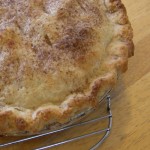 Let’s go with the ‘separating easily into small thin pieces’ bit. Isn’t this what you want your pie crust to do? Flake? Why does or doesn’t it flake? And how do you make it do it?
Let’s go with the ‘separating easily into small thin pieces’ bit. Isn’t this what you want your pie crust to do? Flake? Why does or doesn’t it flake? And how do you make it do it?
I like to remember that cooking is basically chemistry; mixtures, solutions etc. This is one of those times you have to get it right if you want it to do what you want it to do. Flake. With pie crust we are dealing with water and oil; they don’t mix and that’s good.
With flour and a bit of salt in a bowl, cut in cold shortening with a couple of table knives and then fork in some water. The shortening attaches to some of the flour; the water is repelled by the oil and attaches the remaining flour. The water activates the sticky nature of the gluten and the oil is absorbed by the flour leaving some of the flour free and some of the other flour stuck. There you have it flakes when cooked.

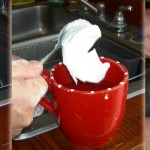 Measuring shortening is a trick, if you want a precise measurement. For this we consult Archimedes of Syracuse (c. 287 BC – c. 212 BC) a Greek mathematician, physicist, engineer, inventor, and astronomer. Archimedes was asked by King Hiero II to calculate the volume of an irregularly shaped Golden Crown without damaging it. In contemplating the problem he took a bath and noticed the displacement of the water in the tub as he got in. So back to pies. Fill a large vessel with water, to the brim. Remove one cup of water. Spoon in shortening until the water brims again. Eureka! One cup of irregularly shaped shortening.
Measuring shortening is a trick, if you want a precise measurement. For this we consult Archimedes of Syracuse (c. 287 BC – c. 212 BC) a Greek mathematician, physicist, engineer, inventor, and astronomer. Archimedes was asked by King Hiero II to calculate the volume of an irregularly shaped Golden Crown without damaging it. In contemplating the problem he took a bath and noticed the displacement of the water in the tub as he got in. So back to pies. Fill a large vessel with water, to the brim. Remove one cup of water. Spoon in shortening until the water brims again. Eureka! One cup of irregularly shaped shortening.
Flaky Pie Crust
* 2-1/2 cups all purpose flour
* 1/2 tsp. salt
* 1 cup shortening very-cold
* 5 to 7 tbsp ice water
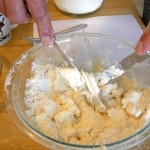
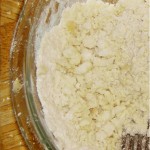 Let’s make a pastry shell. Mix flour and salt in round medium bowl. Cut in flour to the size of peas.
Let’s make a pastry shell. Mix flour and salt in round medium bowl. Cut in flour to the size of peas.
.
.
.
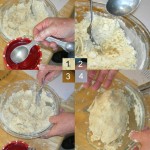 Make a well and fork in Ice Cold water, one tablespoon at a time, lightly fluffing up the well area and being careful not to smash it all up.
Make a well and fork in Ice Cold water, one tablespoon at a time, lightly fluffing up the well area and being careful not to smash it all up.
.
.
.
.
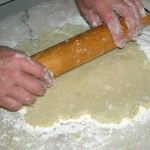
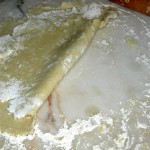 Roll out pastry on a cold, floured surface, from the middle out. Loosen and fold in half for ease in setting a top the pie.
Roll out pastry on a cold, floured surface, from the middle out. Loosen and fold in half for ease in setting a top the pie.
.
.
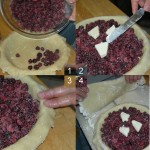
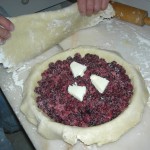 Moisten the edges with water as a gluten sealant. Don’t forget the butter.
Moisten the edges with water as a gluten sealant. Don’t forget the butter.
.
.
.
.